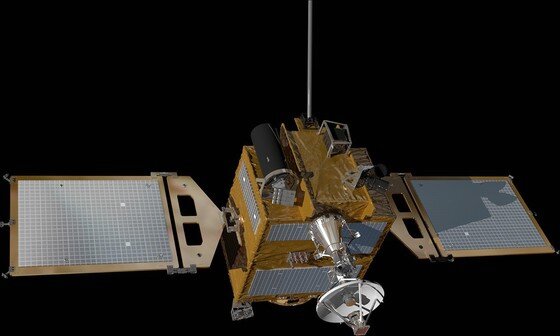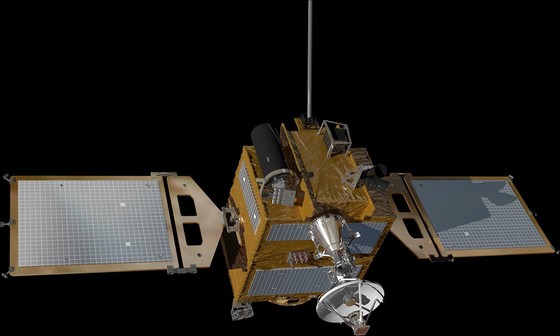 |
| Moon orbiter body (provided by the Ministry of Science and Technology Information and Communication) 2021.04.01 / News 1 |
The outline of Korea’s first lunar exploration project was announced. The lunar orbiter that orbits the moon like a satellite will secure basic data for the lunar landing project in the future, scientific research data, and perform space internet verification.
The Ministry of Science, ICT and ICT held a press conference on March 30 to announce a plan to implement a Korean lunar orbiter.
The Korean Pathfinder Lunar Orbit (KPLO) leaves Earth in August 2022 and arrives in orbit in December, and will begin its full-fledged mission in January 2023.
Like an Earth satellite orbiting the Earth, the lunar orbiter observes the surface of the moon, rotating around the moon once every 118 minutes. It revolves around the moon 12 times a day at 100 km above the lunar surface.
At a press conference, Dr. Eunhyuk Kim said, “The countries that reached the moon (including the orbiter and lander so far) are the United States, the former Soviet Union, Japan, India, Europe, and China. “He explained.
△ High-resolution camera (LUTI, developed by Korea Aerospace Research Institute) △ Wide-field polarization camera (PolCam, developed by Korea Astronomical Research Institute) △ Magnetic field meter (KMAG, developed by Kyunghee University) △ Gamma ray spectrometer (KGRS, developed by Korea Institute of Geoscience and Mineral Resources) ) △Space Internet (DTN) verifier (developed by Korea Electronics and Telecommunications Research Institute) △ShadowCam (Developed by the US Aerospace Administration) payload will be carried.
The high-resolution camera observes the lunar surface with a maximum resolution of 5 m or less and a position error of 225 m or less. Through this, it is expected to search for potential landing sites for the lunar landing ship, which will be developed by 2030. Dr. Eunhyuk Kim said, “Most countries do a technical review (through shooting data) before carrying out the lander project to find a place where landing is easy. This is high,” he explained.
The wide-field polarization camera produces a polarized image of the moon’s surface and a titanium map with a resolution of 100m.
According to the Ministry of Science and ICT, a polarization map on the surface of the moon is the first in the world to be produced. Polarizing cameras consist of two cameras installed at an angle, and through this, they collect data necessary to study space weathering caused by microscopic meteorite impacts on the moon’s surface, solar wind, and high-energy spacecraft. The titanium map will contribute to the lunar surface geological research and resource exploration.
The magnetic field meter is expected to contribute to the study of magnetic anomalies and the lunar space environment that are uniquely distributed on the lunar surface by measuring the minute magnetic field around the moon.
The gamma ray spectrometer is planning to produce more than five types of lunar element maps by collecting gamma ray measurement data on the lunar surface. The results of searching for helium-3, which is attracting attention as a clean energy source, water and oxygen, and construction resources that can be used for lunar base construction, are expected to be used for lunar geology and resource research.
The Space Internet Verifier is planning to verify the space Internet communication technology between the Earth and Moon orbits, and test messages and files, and real-time video transmission. The verification of space communication technology to be verified this time could be the basis for long-distance space communication such as Mars and Jupiter beyond the moon in the future.
ShadowCam is a camera that can shoot high-resolution images of permanently shaded areas, and plans to shoot lunar polar regions where ice is estimated.
At the conference on the day, Lee Chang-yoon, a large public research policy officer, said, “In order to support effective lunar research activities, we set a fund of 8 billion won for four years, and we are thinking of applying it to Moon-Yeon Cheon, Ji-Jeon, Hang Woo-yeon, and individual researchers.” “The achievements are expected to be utilized in the design of the subsequent lunar lander.”
According to the meeting on the day, a study on the purpose and means of the lunar lander project will begin planning research from this month. However, research on moving probes (rovers) that take a long time is being conducted by the Korea Institute of Science and Technology (KIST), and research on nuclear batteries operating in extreme environments is being conducted by the Korea Atomic Energy Research Institute.
The National Aeronautics and Space Administration (NASA) also selected 9 scientists in the United States to participate in lunar scientific research in December last year, and the two countries are continuing international cooperation for successful lunar exploration and joint use of exploration results. It is expected to be able to create excellent performance cases.
“The development of the lunar orbiter, which is the first challenge in Korea, has overcome various difficulties and is currently being stably promoted with the aim of launching in August next year,” said the director of the giant public research policy. “It is expected to contribute to the success of the U.S. moon manned exploration program (Artemis) as well as the foundation stone as the first space exploration achievement of the company.”
